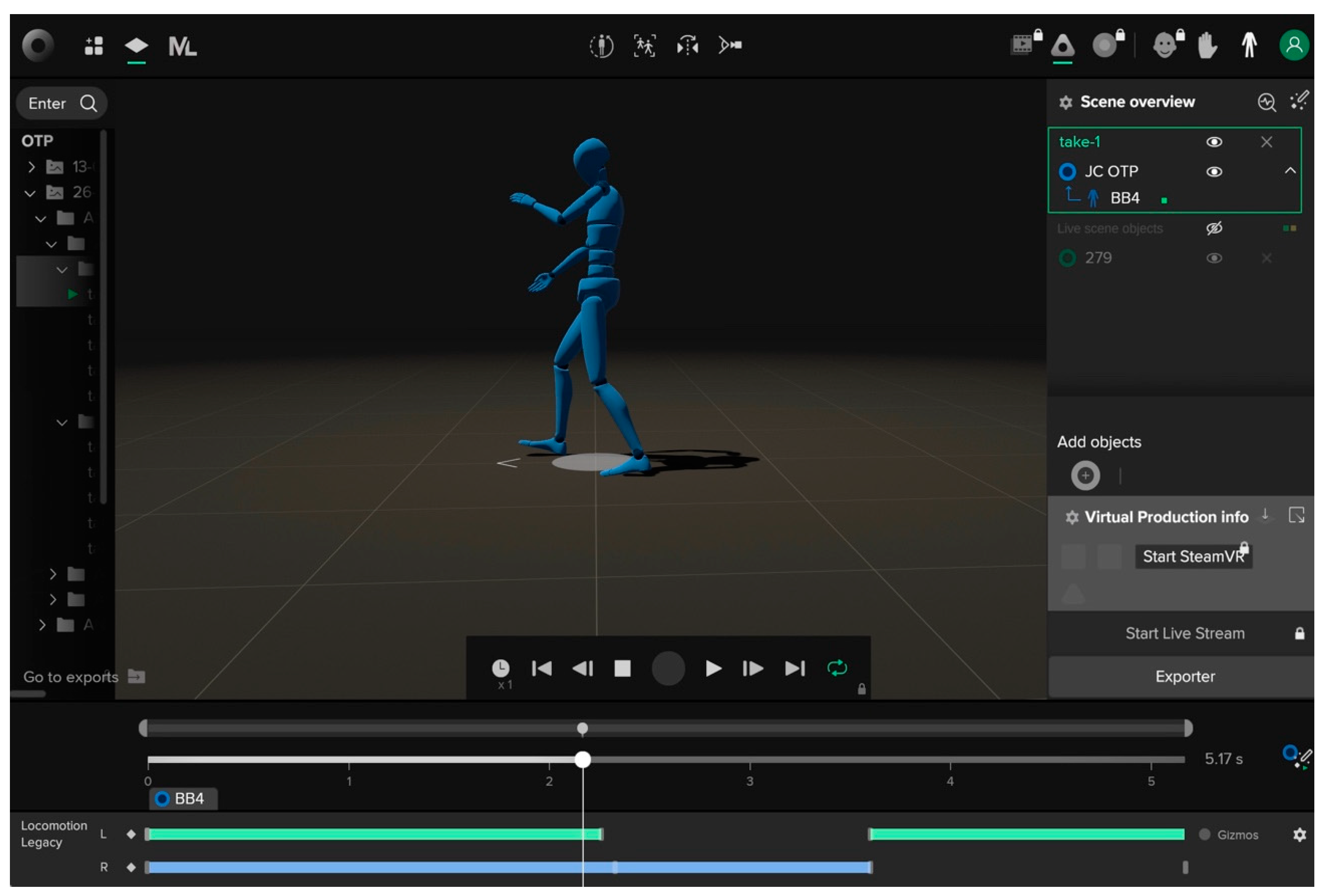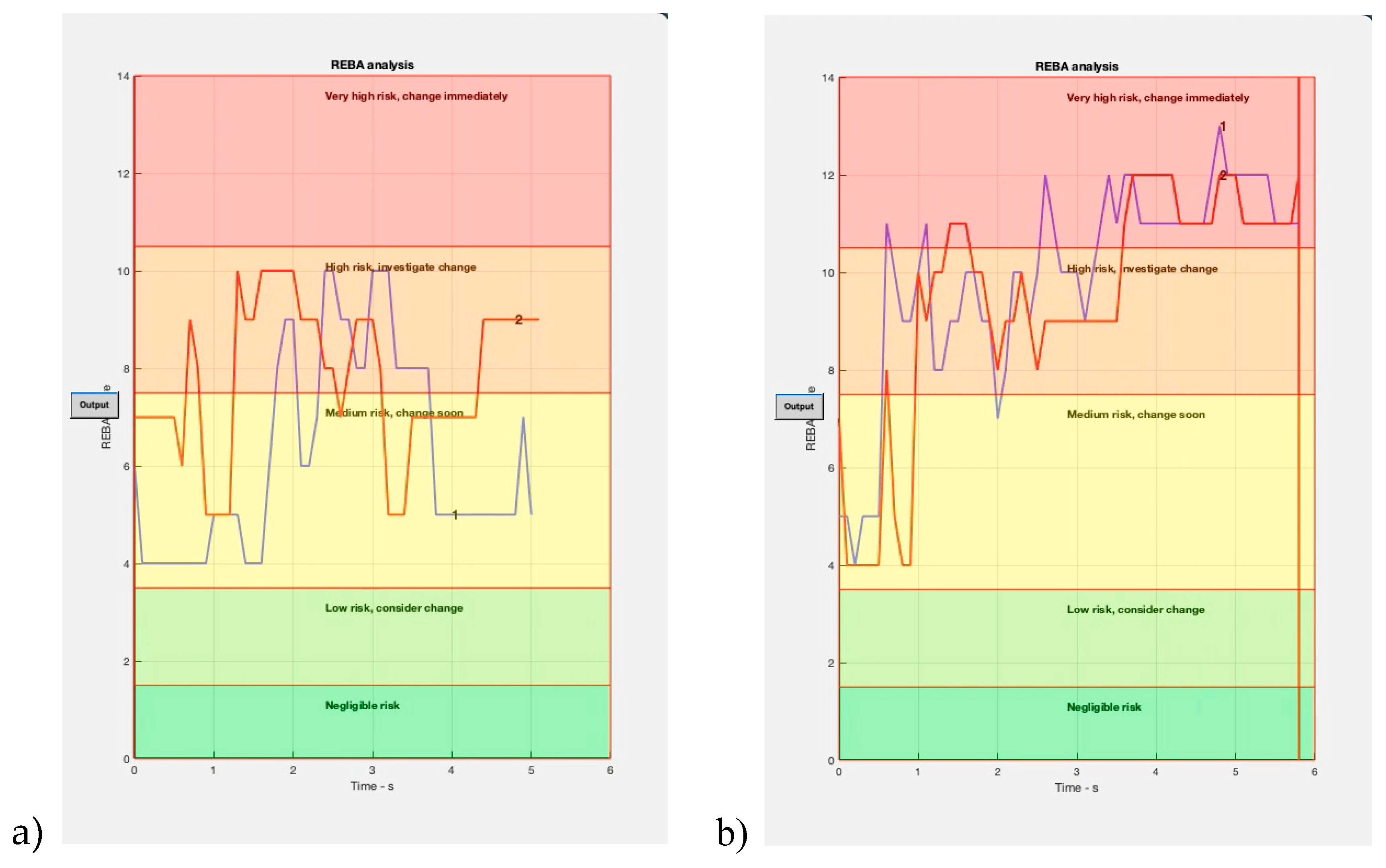Submitted:
22 April 2023
Posted:
23 April 2023
You are already at the latest version
Abstract
Keywords:
1. Introduction
2. Materials and Methods
2.1. Bob-biomechanics
2.2. Rokoko Smartsuit Pro
2.3. Police Physical Intervention Techniques
2.3.1. Operational Tactical Procedures (OTP)
2.3.2. Traditional Techniques
2.4. Research Collaborators
3. Results and discussion
3.1. Asymmetry angles
3.2. Compression force at the L5-Pelvis junction
3.3. Shear force at the L5-Pelvis junction
3.4. Muscle power
3.5. REBA
4. Conclusions
Author Contributions
Funding
Institutional Review Board Statement
Informed Consent Statement
Data Availability Statement
Conflicts of Interest
Abbreviations
| BoB | Biomechanics of Body |
| IMU | Inertial Measurement Units |
| L5-Pelvic junction | Junction of the pelvis with the fifth lumbar vertebra |
| NIOSH | National Institute for Occupational Safety and Health |
| OTP | Operational Tactical Procedure |
| PEP | Police Ergonomics Parameters |
| PIT | Physical Intervention Techniques |
| PST | Personal Security Training |
| REBA | Rapid Entire Body Assessment |
| SBT | Scenario-based training |
| UOF | Use of Force |
References
- Vera-Jiménez, J.C. , Lorente, J.A., González-Herrera, L., Álvarez, J.A., Ferreiro-González, M., Ayuso, J. A Legal and Forensic Medicine Approach to Police Physical Intervention Techniques in High-Risk Situations, Int. J. Environ. Res. Public Health 2020,17(8), 2809. [CrossRef]
- Gistau & Songel (1915). “Destreza. Método práctico para prender, asegurar, conducir delincuentes y de luchar con éxito contra ellos si se oponen á la detención” (Skill. A Practical Method for Gripping, Locking, and Leading Criminals and Fighting against them Successfully if they Oppose Arrest). Madrid: s.n. Published by Revista Técnica de la Guardia Civil (Technical Magazine of the Civil Guard), 61, 1-75.
- Hoover, E.J. Defensive tactics. [Internet] A handbook for law enforcement officers. Ed.: FBI. 1951(revised 1959, original ISBN: 1545487413, ASIN: B06ZZ3MTQ1) [checked on 18th February, 2018] Available at: https://es.scribd.com/doc/53113986/Defensa-Personal-FBI-Defensive-Tactics-Manual.
- Levine, D.; Whitman, J. Complete Krav Maga, Ulysses Press, 2ª Ed., 2016, ISBN:9781612435770, and 1ª Ed., 2007, ISBN: 9781569755730.
- Mor, G. History and Singularity of Krav-Maga, The International Journal of the History of Sport, 35, 2018,15-16. [CrossRef]
- Benito, J.M. ; [Internet] Manual básico de procedimientos y defensa personal policial I (First Basic Manual on Police Personal Defense Procedures) and Manual básico de procedimientos y defensa personal policial II (Second Basic Manual on Police Personal Defense and Procedures), Cuerpo Nacional de Policía, División de Formación y Perfeccionamiento, Centro de actualización y perfeccionamiento (National Police Corps, Training and Development Division, Center for research and improvement). [checked on 18 February, 2023] Available at: https://es.scribd.com/document/74168214/Manual-Defensa-Personal-Policial2.
- Williams JJ, Westall D. SWAT and non-SWAT Police officers and the use of force. J Crim Justice. 2003;31(5):469–74. [CrossRef]
- Chappell, A. T. , and Lanza-Kaduce, L. (2010). Police Academy Socialization: Understanding the Lessons Learned in a Paramilitary-Bureaucratic Organization. J. Contemp. Ethnography 39 (Nr. 2), 187–214. [CrossRef]
- McEwen, T. (1997), "Policies on less-than-lethal force in law enforcement agencies", Policing: An International Journal, Vol. 20 No. 1, pp. 39-59. [CrossRef]
- Garret, B. Stoughton, S.W., A Tactical Fourth Amendment. Virginia Law Review, vol. 103, no. 2, 2017. https://www.virginialawreview.org/articles/tactical-fourth-amendment/ Accessed 2023. /.
- [Internet] Modulos profesionales de formacion previa comunes para vigilantes de seguridad, vigilantes de explosivos y escoltas privados https://sede.policia.gob.es/portalCiudadano/sede_electronica/seguridad_privada/111340_req_especificos.pdf Accessed 2023.
- [Internet] Regulating Private Security Companies in Europe: Status and Prospects 1. https://gsdrc.org/document-library/regulating-private-security-companies-in-europe-status-and-prospects/ Accessed 2023.
- Birzer, M. L. , and Tannehill, R. (2001). A More Effective Training Approach for Contemporary Policing. Police Q. 4 (Nr. 2), 233–252. [CrossRef]
- Andersen, J. P. , Papazoglou, K., Koskelainen, M., Nyman, M., Gustafsberg, H., and Arnetz, B. B. (2015). Applying Resilience Promotion Training Among Special Forces Police Officers. SAGE Open 5 (Nr. 2), 215824401559044. [CrossRef]
- Renden, P. G. , Nieuwenhuys, A., Savelsbergh, G. J., and Oudejans, R. R. (2015). Dutch Police Officers' Preparation and Performance of Their Arrest and Self-Defense Skills: a Questionnaire Study. Appl. Ergon. 49, 8–17. [CrossRef]
- Di Nota, P. M. , and Huhta, J.-M. (2019). Complex Motor Learning and Police Training: Applied, Cognitive, and Clinical Perspectives. Front. Psychol. 10, 1797. [CrossRef]
- Mcneeley, S. , and Donley, C. (2020). Crisis Intervention Team Training in a Correctional Setting: Examining Compliance, Mental Health Referrals, and Use of Force. Criminal Justice Behav. 48, 195–214. [CrossRef]
- Bennell, C. , Alpert, G., Andersen, J. P., Arpaia, J., Huhta, J. M., Kahn, K. B., et al. (2021). Advancing Police Use of Force Research and Practice: Urgent Issues and Prospects. Leg. Crim Psychol. 26, 121–144. [CrossRef]
- Cushion, C. J. (2020). Exploring the Delivery of Officer Safety Training: A Case Study. Policing: A J. Pol. Pract. 5 (Nr. 4), 1–15. [CrossRef]
- Koerner, S. , Staller, M.S., “The Situation is Quite Different.” Perceptions of Violent Conflicts and Training Among German Police Officers, Frontiers in Education, 19, 2022, 777040. [CrossRef]
- Staller, M.S. , Koerner, S., Abraham, A., Poolton, J.M., Topics, Sources and Applicability of Coaching Knowledge in Police Training, Frontiers in Education, 7, 2022, 730791. [CrossRef]
- McLean, K. Stoughton, S.W., Alpert. G.P.,Police Uses of Force in the USA: a Wealth of Theories and a Lack of Evidence. Cambridge Journal of Evidence-Based Policing, vol. 6, 2022, 87-108. Springer Link, https://link.springer.com/article/10.1007/s41887-022-00078-7.
- Koerner, S. , Staller, M.S., “It has Changed, Quite Clearly.” Exploring Perceptions of German Police Trainers on Police Recruits, Frontiers in Education, 10, 2022, 771629. [CrossRef]
- Kleygrewe, L. , Oudejans, R.R.D., Koedijk, M., Hutter, R.I., Police Training in Practice: Organization and Delivery According to European Law Enforcement Agencies, Frontiers in Psychology, 17, 2022, 798067. [CrossRef]
- S. Staller, M., Swen Koerner, Valentina Heil, Isabel Klemmer, Andrew Abraham & Jamie Poolton. “The Structure and Delivery of Police Use of Force Training: A German Case Study.” European Journal for Security Research, vol. 7, 2022, pp. 87-112. Springer Link, https://link.springer.com/article/10.1007/s41125-021-00073-5.
- Cushion, C. , Changing Police Personal Safety Training Using Scenario-Based-Training: A Critical Analysis of the ‘Dilemmas of Practice’ Impacting Change, Frontiers in Education, 07, 2022, 796765. [CrossRef]
- Vera-Jiménez, J.C. , Meléndez-Sánchez, F.L., Álvarez, J.A., Ayuso, J. Analysis of biomechanical parameters in OTP Police physical intervention techniques for occupational risk prevention, Int. J. Environ. Res. Public Health 2022, 19(11), 6615. [CrossRef]
- Mavor, M.P.; Ross, G.B.; Clouthier, A.L.; Karakolis, T.; Graham, R.B. Validation of an IMU suit for military-based tasks. Sensors 2020, 20, 4280. [Google Scholar] [CrossRef] [PubMed]
- McCrary JM, Ackermann BJ, Halaki M. A systematic review of the effects of upper body warm-up on performance and injury. Br J SportsMed. 2015, 49(14), 935-942. [CrossRef]
- Cuixart, S.N. NTP 601: Evaluación de las Condiciones de Trabajo: Carga Postural. Método REBA (Rapid Entire Body Assessment)(Working Conditions Assessment: Postural Loads. REBA method). Instituto Nacional de Seguridad e Higiene en el Trabajo (INSHT) (Spanish National Institute for Health and Safety at Work). 2001. Available online:https://www.studocu.com/ca-es/document/universitat-oberta-de-catalunya/prevencion-de-riesgos-derivados-de-la-organizacion-y-la-carga-de-trabajo/ntp-601-evaluacion-de-las-condiciones-de-trabajo-carga-postural-metodo-reba-rapid-entire-body-assessment/20730183 Accessed 2023.
- Work Practices Guide for Manual Lifting; NIOSH Technical Report 1981, n° 81–122; National Institute for Occupational Safety and Health: Cincinnati, OH, USA, 2017.











Disclaimer/Publisher’s Note: The statements, opinions and data contained in all publications are solely those of the individual author(s) and contributor(s) and not of MDPI and/or the editor(s). MDPI and/or the editor(s) disclaim responsibility for any injury to people or property resulting from any ideas, methods, instructions or products referred to in the content. |
© 2023 by the authors. Licensee MDPI, Basel, Switzerland. This article is an open access article distributed under the terms and conditions of the Creative Commons Attribution (CC BY) license (https://creativecommons.org/licenses/by/4.0/).




